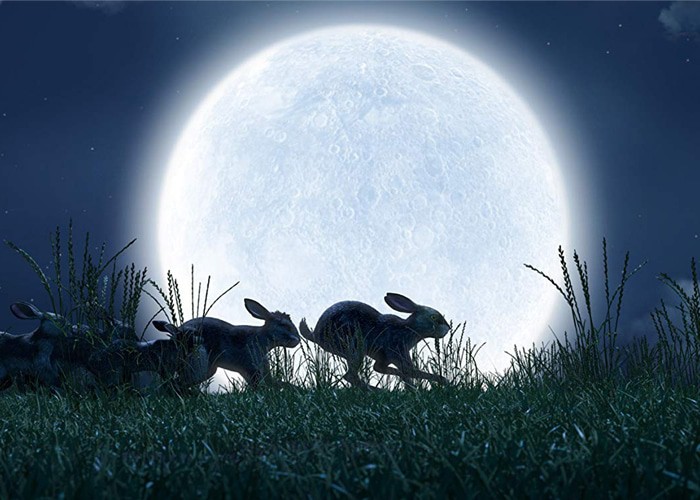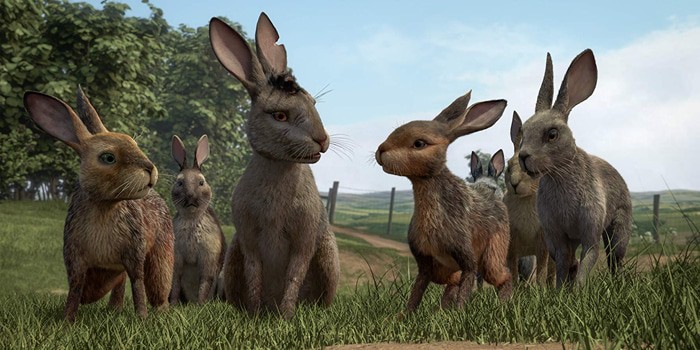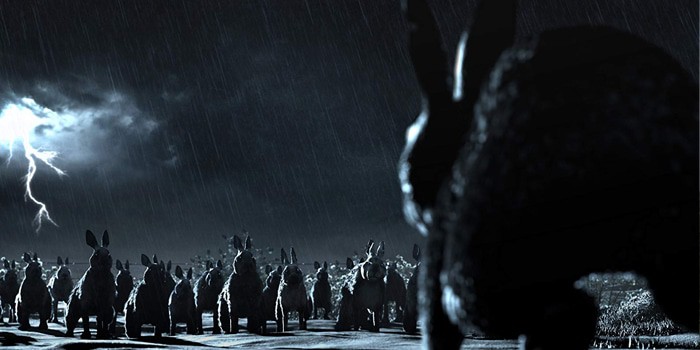
“In the beginning, the great Frith made the world…”
It seems somewhat of an accidental tradition that every two decades or so, a new adaptation of Richard Adams‘ beloved novel Watership Down is unleashed upon us. Begun as improvised stories to tell his children during long car journeys, the immortal tale of a group of rabbits trying to find a new home amidst dangers from man and other murderous creatures was first adapted for the big screen in 1978 with a television series following in 1999. This new computer-generated miniseries is a co-production between Netflix and the BBC and is separated into four episodes: “The Journey,” “The Raid,” “The Escape,” and “The Siege.”
Like the 1978 film, the show features an all-star mainly British voice cast including James McAvoy, Nicholas Hoult, John Boyega, Rosamund Pike, Olivia Colman, Daniel Kaluuya, and Ben Kingsley, inevitably as the villain. The story follows rabbit Hazel (McAvoy) leading a colony of rabbits away from their home after his gifted younger brother Fiver (Hoult) has visions of the warren being subjected to horrendous death and destruction by property developers. On the way they encounter cats, dogs, and a particularly grumpy Scottish gull while being stalked by Efrafa, a nearby warren which can only be described as a rabbit fascist state, led by Kingsley’s General Woundwort.
Even after the novel’s publication, Adams maintained that there was no allegory meant in Watership Down and it was a simple tale for his children. However, what was inferred originally was later capitalized on for adaptations and that continues in this engaging and gripping series which underlines the importance of nature in the balance of life, a relevance which certainly has taken a nosedive politically. There’s a familiar fracture between the two parties of our main rabbits and the Efrafans, with the former holding out several olive branches to the latter throughout, only for them to laugh in their faces. No doubt imagining the very ludicrous idea of a superior race being treated equal to another. Where have we heard that before?

Also central is the approach to mortality and how the rabbits deal with that with Fiver’s visions and Woundwort’s continual threat of execution to subordinates, and the acceptance of death, be it in everyday life or as sacrifice. Death is presented as a very normal thing, with the enemies of rabbit folk legend El-Ahrairah killing his children regularly via fox, bird of prey, or even automobile. It’s a very healthy way to discuss death as a concept with children and I can imagine it being a springboard to those debates as well as it remaining an emotional tool.
Something that has dogged the 1978 adaptation and has come up many times in previews of the Netflix show is its very suitability for children. While the original stories were for younger people, the ’78 film was for an older audience but fell into the trap of the widely thought myth that animation is solely for children. Watership Down has obviously taken the older film into consideration – as well as the previous adaptation that was marketed and aired directly to children – and rides the line well, with a well-conceived approach that restrains itself with the more terrifying aspects without sacrificing the drama. The most upsetting element for children may be Fiver’s visions, especially the initial view of the warren being destroyed. The visions have been conceptualized as Fiver being drawn into a strange kind of limbo, a cross between a VR display and the one ring’s netherworld as shown in Peter Jackson’s The Lord of the Rings, and the images of terrified rabbits frozen in time as they try to escape might be too much for younger children.
But any of those parts are contrasted with the sense of adventure throughout the story, with Tom Bidwell’s script well-written and balanced perfectly across the four parts. There are obvious connections to be made with the ’78 film beyond the scary parts with this version a lot less stylized, with a contemporary CG animation style which both helps it keep a realistic edge, and with it being hard to tell some rabbits apart. There are clear moments where the original film is being referenced, such as the opening tale of rabbit deity Frith and the creation of El-Ahrairah told in a puppetry-based animation style, but also big moments that have been excised, notably the near-death experience Hazel has, famous for its use of Art Garfunkel and Mike Batt’s song “Bright Eyes.” Not a note of the song appears, with music left to a rather generic Emeli Sande track and the excruciating Sam Smith end title song (didn’t anyone learn from Spectre?). In fact, music feels sometimes like an afterthought, with Federico Jusid’s lyrical score far too low in the mix, severely lessening its power.

Perhaps because of the animation style, the story feels sometimes like it doesn’t have the impact needed viscerally and emotionally, however it’s made up by an excellent voice with performances led by McAvoy’s stable Hazel and Boyega’s lively Bigwig, although Hoult’s Fiver, while satisfying enough in the series, feels a tad weak when compared to the original’s Richard Briers. Blessedly there’s no attempt to anthropomorphize any of the animal characters, which helps the world Adams created remain self-contained and as a result rather wondrous.
Netflix and the BBC have posited Watership Down as a big part of their holiday programming, and it will delight both old and young alike. It’s a wonderfully faithful adaptation that binge-watchers will find easy to consume due to its tense structure, and it will engage younger viewers while not being too much for them. In fact, while it doesn’t reach the heights of the 1978 film it remains a welcome opportunity to introduce children to the sheer beauty of Richard Adams’ stories without things getting too intense. For Frith’s sake, I hope we get more of them.
Related Topics: James McAvoy, john boyega, Netflix, Nicholas Hoult, rosamund pike

